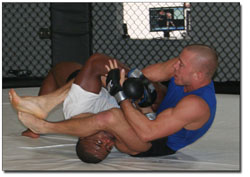|
| ||
| Diet of a cage fighter
by Ari LeVaux There are many motivations for paying attention to what you eat: ensuring proper nutrition, preventing disease, losing weight and boosting intelligence all make their claims, alongside a host of philosophical, ethical and religious concerns. These are all important considerations, but what about foods to help you beat people up? To find out if there’s a real-life counterpart to Popeye’s spinach, I recently sat down with some cage fighters to learn what’s really inside that proverbial can of whoop-ass. Mixed martial arts (MMA) competition, aka cage fighting, began in 1993 as a sort of science experiment aimed at answering a long-debated question: Which martial art is the best? The Ultimate Fighting Championship (UFC) was designed to settle this issue by pitting experts in various hand-to-hand combat disciplines against each other. Wrestlers, kickboxers, boxers and experts in karate, sumo and jiu-jitsu all competed in the experiment, now known as UFC 1. Fights were decided by knockout, decision, fight-stoppage by the referee (in the event one fighter was getting pummeled and not defending himself), or submission, in which one fighter surrenders. Albuquerque is a hub for MMA training, thanks largely to Jackson’s Submission Fighting, an Albuquerque gym where some 60 professional fighters, including four past and present world champions, train. Hoping to learn about the relationship between nutrition and cage domination, I sat down at an Albuquerque Italian restaurant with two of Jackson’s fighters, Keith “The Dean of Mean” Jardine, a highly ranked light-heavyweight title contender, and his girlfriend, Jodie Esquibel, a professional boxer scheduled to fight her first MMA match on Aug. 25. While many MMA competitors are notably muscle-bound, the advanced cardiovascular training necessary to beat each other silly for several rounds sets them apart from bodybuilders. “Bodybuilders do almost zero cardio,” Jardine explains. “Maybe 20 minutes walking a treadmill at the most, because their body wants that muscle so bad.” In other words, when you’re below 4 percent body fat, like a bodybuilder, your body will begin digesting its own muscle if too much energy is expended. Punching with intent, as Jardine puts it, is tiring. So is kicking, blocking, wrestling, body-slamming and maneuvering your opponent into a “Peruvian Necktie,” “Rear Naked Choke,” “Anaconda” or some other submission hold. That’s why unlike bodybuilders or weight-loss enthusiasts, MMA fighters eat plenty of carbohydrates to get them through the intense cardio workout sessions without signaling their bodies to start digesting muscle. Jardine starts his day like a lot of farmers I know, with a bowl of oatmeal, along with an un-farmer-like protein shake. He likes oatmeal for the same reason farmers and other hard workers do: because it’s full of slow-burning calories that will sustain you through prolonged physical activity. The protein shake is for muscle nourishment and regeneration, ahead of the morning workout. “If you eat foods with a high glycemic index,” Jardine cautions, “your workout will suck.” The glycemic index (GI) rates the amount of simple sugars in food, which affects blood glucose levels. High GI foods, like white bread or sugar, can trigger a sugar high, followed by a crash. Low GI foods, like oatmeal, keep the body’s insulin levels – and hence energy levels – more constant. They also keep you feeling full longer. In addition to allowing a good workout, GI foods are also good for long-term health, in terms of cholesterol and heart disease. If you watch a cage fight you might not think long-term health is a concern to most combatants, but statistically speaking, there are fewer serious injuries in MMA than in boxing, football and even cheerleading. And it’s much safer than being fat.Jardine’s rule of thumb for estimating a food’s GI is to check the proportion of total carbohydrates to fiber, usually measured in grams. In general, the higher the proportion of fiber, the lower the GI. “The most important meal,” Jardine says, “is right after a workout, when you have a short window for using food for muscle nourishment, and not storage.” The window for eating after a workout is an hour at most. After that, a calorie deficit may cause the body to digest its muscle for energy. The post-workout meal, like all meals in the , is protein-heavy, to nourish the muscles that have been worked. While protein shakes are the norm, Jardine says, they aren’t necessary, just convenient. “It’s easier than bringing a bunch of chicken to the gym.” At Paisano’s, Jardine’s favorite Italian restaurant, both fighters ordered chicken. Esquibel ordered marsala while Jardine ordered his all-time favorite, chicken parmesan. Chicken, being lean and protein-rich, is a favored food in MMA circles. The lovebird fighters savored their glasses of the house red, a rare treat made possible by the fact that neither has a fight in the next two months. When a fight approaches and training camp begins, the booze dries up. “The worst thing about wine for me is the mental effects,” Esquibel says, underscoring the fact that while the sport may look thuggish, cage fighting requires mental sharpness. Even one sub-par workout during a training camp is one too many. In addition to its mind-numbing effects, wine makes it harder to stay hydrated and contains too much sugar – sugar being the No. 1 no-no in the . “When you take sugar out of your diet, you can really feel it,” says Jardine, who in the cage might not strike you as the sensitive type. “And once you’ve cleaned up your eating, you can feel it when you eat something wrong.” And your opponent, perhaps, will be the one feeling something’s wrong if you stick to your fiber and protein, and avoid sugar. It won’t guarantee success, but it will surely tilt the cage in your favor. •
|


